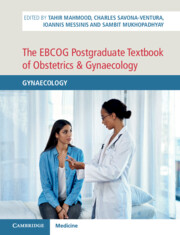Book contents
- The EBCOG Postgraduate Textbook of Obstetrics & Gynaecology
- The EBCOG Postgraduate Textbook of Obstetrics & Gynaecology
- Copyright page
- Dedication
- Contents
- Videos
- Contributors
- Preface
- Section 1 Basic Sciences in Gynaecology
- Section 2 Menstrual Disorders
- Section 3 Reproductive Endocrinology and Infertility
- Section 4 Contraception and STIs
- Section 5 Post-Reproductive Care
- Section 6 Vulva and Vagina
- Section 7 Cervix
- Section 8 Uterus
- Section 9 Ovary and Fallopian Tubes
- Section 10 Operative Gynaecology
- Section 11 Public Health Issues in Gynaecology
- Section 12 Miscellaneous
- Chapter 58 Prophylactic Bilateral Salpingo-oophorectomy
- Chapter 59 Immunotherapy for Gynaecological Cancers
- Chapter 60 Radiotherapy for Gynaecological Cancer
- Chapter 61 Clinical Audit and Risk Management in Gynaecology Practice
- Chapter 62 Research in Obstetrics and Gynaecology
- Chapter 63 Skills Training and Simulation
- Chapter 64 Practical Medical Education Science for Clinical Teaching Sites
- Chapter 65 Algorithm for Managing Vulvovaginal Symptoms
- Index
- Plate Section (PDF Only)
- References
Chapter 65 - Algorithm for Managing Vulvovaginal Symptoms
from Section 12 - Miscellaneous
Published online by Cambridge University Press: 24 November 2021
- The EBCOG Postgraduate Textbook of Obstetrics & Gynaecology
- The EBCOG Postgraduate Textbook of Obstetrics & Gynaecology
- Copyright page
- Dedication
- Contents
- Videos
- Contributors
- Preface
- Section 1 Basic Sciences in Gynaecology
- Section 2 Menstrual Disorders
- Section 3 Reproductive Endocrinology and Infertility
- Section 4 Contraception and STIs
- Section 5 Post-Reproductive Care
- Section 6 Vulva and Vagina
- Section 7 Cervix
- Section 8 Uterus
- Section 9 Ovary and Fallopian Tubes
- Section 10 Operative Gynaecology
- Section 11 Public Health Issues in Gynaecology
- Section 12 Miscellaneous
- Chapter 58 Prophylactic Bilateral Salpingo-oophorectomy
- Chapter 59 Immunotherapy for Gynaecological Cancers
- Chapter 60 Radiotherapy for Gynaecological Cancer
- Chapter 61 Clinical Audit and Risk Management in Gynaecology Practice
- Chapter 62 Research in Obstetrics and Gynaecology
- Chapter 63 Skills Training and Simulation
- Chapter 64 Practical Medical Education Science for Clinical Teaching Sites
- Chapter 65 Algorithm for Managing Vulvovaginal Symptoms
- Index
- Plate Section (PDF Only)
- References
Summary
Bothersome genital symptoms (pruritus, irritation, dyspareunia, vaginal discharge, malodour, burning) are common problems. The main challenge for clinicians is to correctly diagnose the cause of the symptoms as they are non-specific and often have multiple overlapping aetiologies. The aim of this chapter, written by a multidisciplinary team of vulvovaginal experts (gynaecology, dermatology and infectious disease) is to present a clinical flow chart algorithm that can help the clinician reason through overlapping symptoms to obtain a more accurate diagnoses. Six principles were endorsed: (1) locating the discomfort (vulva, clitoris, vestibule, vagina, cervix, pelvis); (2) considering more than one entity; (3) evaluating each symptom separately (4) using pH and wet mount microscopy; (5) obtaining a follow-up visit after 2–4 weeks; (6) performing a biopsy for dermatological conditions that are resistant to treatment.
- Type
- Chapter
- Information
- The EBCOG Postgraduate Textbook of Obstetrics & GynaecologyGynaecology, pp. 544 - 551Publisher: Cambridge University PressPrint publication year: 2021

